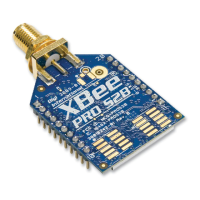XBee ZigBee networks Coordinator operation
XBee/XBee-PRO ZigBee RF Modules User Guide 38
could, for example, implement one endpoint that supports a Smart Energy load controller, and another endpoint
that supports other functionality on a private profile.
ZigBee device profile
Profile ID 0x0000 is reserved for the ZigBee Device Profile. This profile is implemented on all ZigBee devices.
Device Profile defines many device and service discovery features and network management capabilities.
Endpoint 0 is a reserved endpoint that supports the ZigBee Device Profile. This endpoint is called the ZigBee
Device Objects (ZDO) endpoint.
ZigBee Device Objects (ZDO)
The ZDO (endpoint 0) supports the discovery and management capabilities of the ZigBee Device Profile. A
complete listing of all ZDP services is included in the ZigBee specification. Each service has an associated cluster
ID.
The XBee ZB firmware allows applications to easily send ZDO messages to devices in the network using the API.
See ZDO transmissions on page 68 for details.
Coordinator operation
Forming a network
The coordinator is responsible for selecting the channel, PAN ID (16-bit and 64-bit), security policy, and stack
profile for a network. Since a coordinator is the only device type that can start a network, each ZigBee network
must have one coordinator. After the coordinator has started a network, it can allow new devices to join the
network. It can also route data packets and communicate with other devices on the network.
To ensure the coordinator starts on a good channel and unused PAN ID, the coordinator performs a series of
scans to discover any RF activity on different channels (energy scan) and to discover any nearby operating PANs
(PAN scan). The process for selecting the channel and PAN ID are described in the following sections.
Channel selection
When starting a network, the coordinator must select a “good” channel for the network to operate on. To do this,
it performs an energy scan on multiple channels (frequencies) to detect energy levels on each channel. Channels
with excessive energy levels are removed from its list of potential channels to start on.
PAN ID selection
After completing the energy scan, the coordinator scans its list of potential channels (remaining channels after
the energy scan) to obtain a list of neighboring PANs. To do this, the coordinator sends a beacon request
(broadcast) transmission on each potential channel. All nearby coordinators and routers (that have already
joined a ZigBee network) will respond to the beacon request by sending a beacon back to the coordinator. The
beacon contains information about the PAN the device is on, including the PAN identifiers (16-bit and 64-bit). This
scan (collecting beacons on the potential channels) is typically called an active scan or PAN scan.
After the coordinator completes the channel and PAN scan, it selects a random channel and unused 16-bit PAN ID
to start on.
Security policy
The security policy determines which devices are allowed to join the network, and which device(s) can
authenticate joining devices. See ZB security on page 74 for a detailed discussion of various security policies.

